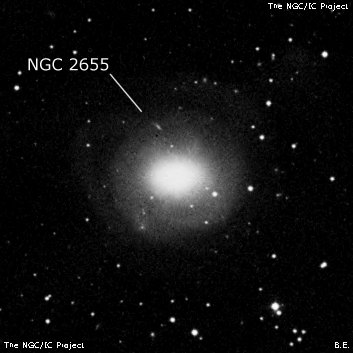
William Herschel discovered NGC 2655 = H I-288 = h520 on 26 Sep 1802 (sweep 1111, his second to last sweep) and recorded "vB, cL, lE, suddenly mbM. I suspect it to be a cl of star." CH's reduced position is 5' north of UGC 5152. On 21 Aug 1828 (sweep 170), John Herschel wrote, "vB; lE; in parallel; psmbM, to a nucl = a * 12m; 30". Has a L * p and another f, at a considerable distance." Horace Tuttle independently found the galaxy on 8 Apr 1850 with the 15-inch Merz refractor at the Harvard College Observatory and it was reported as HC 12 in the AN #1453 discovery list. The HCO position is accurate.
According to Michael Hoskin's "Unfinished Business: William Herschel’s Sweeps for Nebulae", NGC 2655 = H I-288, NGC 2908 = H III-977 and NGC 3057 = H III-978 were the last three entries in his third catalogue to officially bring the total to 500 -- added after Herschel's third catalogue had been sent to the Royal Society for publication in 1802. A month after submission, Caroline discovered that only 497 objects were included and on 26 Sep 1802, Herschel found 6 new nebulae. Three of these (including NGC 2655) were added by Caroline to the catalogue, and three were saved for a possible additional catalogue. A few nights later (30 Sep 1802) WH discovered 4 more nebulae but these along with 3 from earlier years that were overlooked were added at the last minute to the proofs to bring the actual total to 510, as WH was finished with his sweeps.
400/500mm - 17.5" (2/1/92): very bright, moderately large, elongated 3:2 E-W, 3'x2', even concentration to an unusually bright core and almost stellar nucleus. There appears to be a sharper light cut-off along the north side. Forms an equilateral triangle with mag 9.2 SAO 6687 10' NE and mag 7.4 SAO 6692 11' SE. Brightest in a group (LGG 165) including NGC 2591, 2715 and 2748.
600/800mm - 24" (3/21/20): at 260x; very bright, very large, slightly elongated 5:4 E-W, at least 4' x 3.2' and perhaps larger (outer periphery very diffuse), very strong concentration with an unusually bright core and an intense nucleus. At 375x, the nucleus increases to a a confused stellar peak. Two stars are superimposed on the southwest side; one near the edge of the core region and the second inside the fainter outer halo.
Notes by Steve Gottlieb